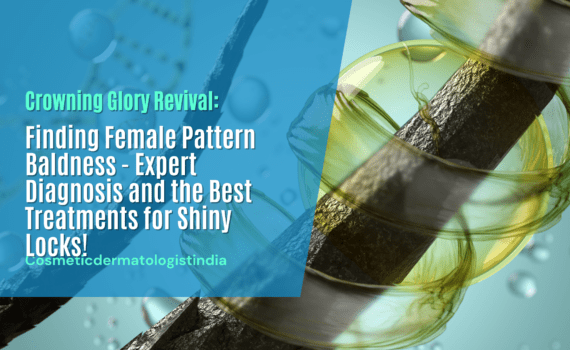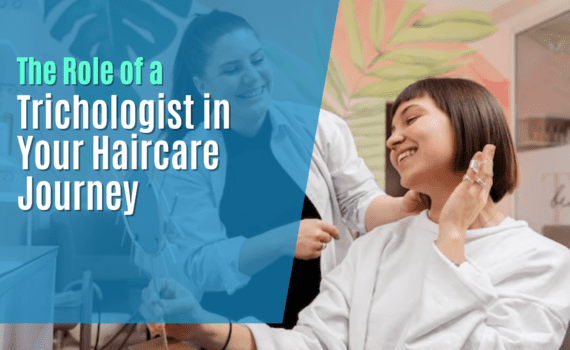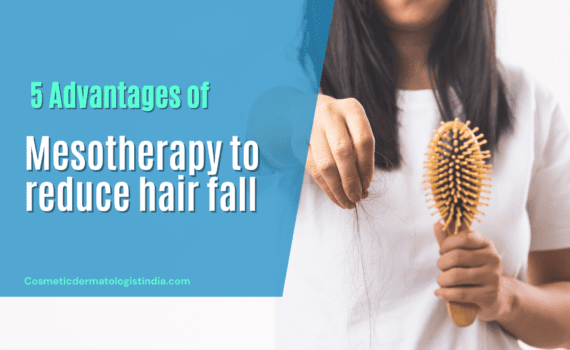
Crowning Glory Revival: Finding Female Pattern Baldness – Expert Diagnosis and the Best Treatments for Shiny Locks!
Hair Today, Gone Tomorrow is a famous phrase of modern times. Hair loss affects more than a third of women throughout their lives. Thinning hair, bald patches, or hair loss are common symptoms experienced by postmenopausal women, which are mostly caused by hormonal changes. The effects of hair loss on women are more noticeable than on men because of greater awareness and less social tolerance. A woman’s mental health and overall happiness might take a hit when she experiences hair loss.
What are the types of Hair Loss in Women?
The most common form of hair loss in men and women is androgenetic alopecia, commonly known as female pattern baldness in women. This type of hair loss is typically familiar with age. Most hair loss cases that the best trichologists in Mumbai see are female pattern baldness. The prevalence of androgenetic alopecia in women older than 70 is about 50% and 8.7% in women between the age of 17-29 years, 20.4% in the age group of 30-39 years, and 29.2% in women aged 40-49.
In simple words, this means that there are a large number of women around the world who are losing hair daily despite using all the right hair products, eating the right foods, and taking care of their hair, but are clueless about what is causing such a pattern of hair loss and reduction of hair volume.
How to identify female pattern baldness
In women, the hair loss pattern is different than in men, and there is little or no chance of complete balding. The hair loss starts from the part line and progresses in an M-shaped pattern. It can begin at any time in women’s lives after puberty. Hair loss becomes more noticeable during menopause. Here are some signs to help identify female pattern baldness
- Thinning of hair on the top of the scalp.
- Widening of the part, which is the earliest sign of pattern baldness
- Reduced hair density because hair follicles miniaturize and produce thinner, shorter hairs, affecting overall hair density.
- Visible scalp because of thinning hair
Family history is also a contributing factor to female pattern baldness. So, if you have close female relatives, such as your mother, grandmother, or sisters, who have experienced thinning hair or hair loss, you may be at higher risk of developing it yourself.
Suppose you suspect that you are experiencing the signs of female pattern baldness. In that case, you must consult the best trichologist in India specializing in androgenetic alopecia and treatment. An expert trichologist in Mumbai, like Dr Rinky Kapoor, will evaluate your scalp, medical history, and family history to determine the underlying cause of hair loss and thinning and recommend the appropriate treatment for female pattern baldness.
Female pattern baldness can significantly impact a woman’s self-esteem and emotional well-being. Seeking support from the top trichologist in Mumbai can help you cope with the emotional effects of hair loss.
What causes female pattern hair loss?
The main culprit of pattern hair loss is increased androgen hormone activity. Androgens are typically male hormones, but women also produce a small amount of them. Excessive levels of hormones such as testosterone and DHT reduce the size of hair follicles, and eventually, the hair grows thinner and smaller. Hormonal changes associated with menopause, pregnancy, childbirth, or polycystic ovary syndrome (PCOS) can all influence androgen levels and contribute to hair loss in women. However, other reasons can trigger a pattern of hair loss.
- Genetics: when the hair follicle genes are sensitive to androgen, particularly dihydrotestosterone (DHT).
- Age
- Environmental factors include stress, poor nutrition, some medications such as hormonal contraceptives, antidepressants, and chemotherapy drugs, and exposure to toxins and pollutants.
- Medical conditions include thyroid, diabetes, autoimmune diseases, and scalp issues such as alopecia or seborrheic dermatitis.
- Poor lifestyle habits, such as excessive hairstyling or chemical treatments, tight hairstyles that pull on the hair (traction alopecia), crash dieting, or nutritional deficiencies, weaken the hair and increase hair loss over time.
Female pattern hair loss causes vary from woman to woman. It combines different factors, including genetic predisposition, hormonal balances, and environmental triggers. Trichologists in Mumbai begin by treating the underlying causes and then use various treatment approaches to treat female pattern hair loss.
Expert Diagnosis and the Best Treatments for Shiny Locks!
Types of female pattern hair loss
There are three types of androgenetic alopecia
- Type I: Minimal thinning concealed with hair styling techniques.
- Type II: Widening caused by decreasing volume, particularly in the midline.
- Type III: characterized by a see-through scalp due to generalized hair thinning.
The idea that androgenetic alopecia therapies are exclusively for males is a common fallacy. As a result of shame and embarrassment, many women try to hide their thinning hair by getting frequent salon treatments, dyeing their hair a different color, or sporting a new hairstyle. They won’t last forever, though; only the top trichologist in Mumbai can provide the treatments that work to boost confidence and quality of life.
To begin treating female pattern baldness, a trichologist or hair specialist in Mumbai would review the patient’s medical history and thoroughly examine the scalp. The specialist will also look for symptoms of inflammation or a fungal infection, such as dandruff. They may also suggest additional testing, such as a blood test or an inquiry into thyroid function or iron deficiencies.
Important Therapies may be prescribed by the Best Trichologist in Mumbai after the test, including:
Medications: the gold standard for non-invasive hair thinning treatments for women.
- Minoxidil promotes hair growth when applied topically to the scalp. Try using a 2% or 5% minoxidil solution to combat hair thinning.
Keeping your hair and scalp fresh and clean is essential before applying minoxidil. Both dropper and spray pump applications are possible. Rub it into the scalp twice daily, where hair loss first began. After a light massaging, let it sit for at least 40 minutes. Next, rinse it off.
- Androgen receptor antagonists, such as spironolactone or Aldactone.
Suppose the trichologist in Mumbai determines that anemia or iron deficiency is to blame for your thinning locks. In that case, one treatment option is to take iron supplements to improve hemoglobin levels.
The QR678 method for regrowing hair
Invented by Dr. Rinky Kapoor and Dr. Debraj Shome, the patented method for addressing hair loss, QR678, stimulates follicle regeneration, enhancing both the quality and “quantity” of hair. QR678 contains proteins, vitamins, amino acids, minerals, growth factors, and polypeptides to promote healthy hair renewal. The FDA has approved QR678 in both India and the USA. It is a risk-free method that has helped men and women of all ages with their hair loss problems. Direct injection of QR678 solution into the scalp is performed. Total treatment duration is 8-12 months; visible benefits often appear after 4–6 months.
Permanent hair Replacement or Hair Transplant Treatments
This method is intended to treat androgenic alopecia in women, a condition characterized by noticeable bald spots and severe hair loss. A strip of hair is removed from the back of the head and then transplanted in the balding areas or patches. Modern hair restoration methods sometimes include follicular unit transplantation. This technique involves the hair specialist removing a small section of the scalp and dividing it into multiple little grafts, each with a small number of hairs. Following this, a slit is made on the bald scalp using a blade or a needle, and the grafts are planted within. Once transplanted, the hair grows naturally.
What hair transplant is a good option for the treatment of Female pattern hair loss
With a success rate of 60 to 80 percent, female hair transplants help women get their old hairdo back permanently. Some more benefits include
- Getting longer, healthier hair and being able to style it in any way you want
- Overcoming the emotional distress associated with hair loss
- The regrown hair will grow naturally so you can do all your activities like intense workouts, dancing, swimming, coloring, and perming.
Hair transplants option for Females
Women and men undergo the same hair transplantation surgery. Both FUT and FUE are widely utilized methods. A woman’s specific form of hair loss dictates the process that will be most effective for her.
Because there is no permanent donor region in women, it is highly crucial to choose a skilled and experienced trichologist in India for female hair transplants. Female pattern baldness is more subtle and requires the surgeon to be more precise during the hair transplant surgery. Therefore, you must seek the services of a specialist in hair restoration treatment like Dr Rinky Kapoor, who has extensive experience with female-specific hair transplant procedures in India. You can even request to see before and after pictures at the clinic to better understand the potential outcomes.
To ensure the tremendous success of the female hair transplant process, the surgeon will do a thorough evaluation of the donor and recipient sites before surgery. Before any transplantation, the surgeon must ensure that the donor site is suitable by measuring the density of follicular units, the diameter of the hair shaft, and the hair’s color, texture, and wave. Additionally, the surgeon will also examine the density of follicular units. Two or three hairs per follicular unit is the minimum for a hair transplant to be effective. The Mumbai trichologists will locate and mark the balding regions on the recipient site. The procedure’s success depends on the patient’s hair and scalp color.
Hair transplantation techniques using FUT or FUE
There are essentially three stages to a hair transplant in India.
- This process involves removing hair follicles from a donor site. It is common practice to approach this task from the sides or rear of the head where the hair density is healthy.
- The graft transplantation process. To ensure that the transplanted hair grows in the same direction and at the same angle as the donor’s hair, the best trichologist in Mumbai makes tiny incisions in the recipient area and implants the grafts there.
- Recovery: New hair grows in four months following a hair transplant, and the transplanted hair falls out three weeks after the procedure. Consequently, adhering to the postoperative instructions is critical to ensure good hair health.
When doing a hair transplant in India using the FUT technique, also known as strip harvesting, the surgeon removes a small section of donor hair to facilitate follicular extraction. A tiny lining scar is all that’s left after the operation. Individual follicular units are harvested from the donor area of the scalp and implanted in the recipient area during the FUE hair transplant technique in India. The top Indian hair transplant doctors will utilize a method tailored to the patient’s specific level of hair loss.
The QR678 hair restoration method can be used both before and after the hair transplant procedure to improve the results, reduce the recipient site areas, infuse health into the hair follicles, and significantly reduce the price of hair transplants for female pattern baldness treatment.
Women undergoing hair transplant procedures under the expert guidance of Dr Rinky Kapoor do not need to shave their heads or trim their hair before the transplant procedures. Dr Kapoor, a top trichologist in Mumba, has expertise in advanced methods such as the no-shave FUE hair transplant and robotic hair transplants with the Punch Hair Matic Hair Robot for micro grafting. These techniques ensure the procedure is safer and quicker and delivers accurate outcomes. Newly transplanted follicular units will produce new hair strands approximately two months post-procedure, with complete growth visible within 8-10 months. The hair expert advises patients to keep a healthy diet and exercise regularly to guarantee good blood supply to the hair follicles.










